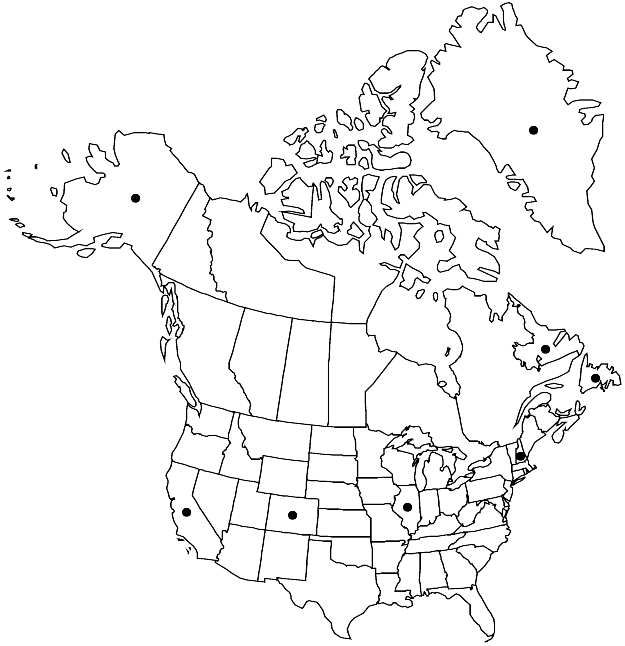Difference between revisions of "Imbribryum alpinum"
Bryologist 108: 449. 2005.
FNA>Volume Importer |
imported>Volume Importer |
||
| (6 intermediate revisions by 2 users not shown) | |||
| Line 7: | Line 7: | ||
|year=2005 | |year=2005 | ||
}} | }} | ||
| − | |basionyms={{Treatment/ID/ | + | |basionyms={{Treatment/ID/Basionym |
|name=Bryum alpinum | |name=Bryum alpinum | ||
|authority=Hudson ex Withering | |authority=Hudson ex Withering | ||
| + | |rank=species | ||
| + | |publication_title=Syst. Arr. Brit. Pl. ed. | ||
| + | |publication_place=4, 3: 824. 1801 | ||
}} | }} | ||
|synonyms= | |synonyms= | ||
| Line 26: | Line 29: | ||
|elevation=low to high elevations (0-2500 m) | |elevation=low to high elevations (0-2500 m) | ||
|distribution=Greenland;Nfld. and Labr.;Alaska;Calif.;Colo.;Ill.;N.H.;w;n Eurasia;n Africa. | |distribution=Greenland;Nfld. and Labr.;Alaska;Calif.;Colo.;Ill.;N.H.;w;n Eurasia;n Africa. | ||
| − | |discussion=<p>Imbribryum alpinum is a relatively rare boreal-temperate species characterized by narrow, shiny-metallic red leaves and incrassate, elongate distal laminal cells; capsules are rare. Most reddish plants similar to this species in the western United States do not conform well to this set of characters. Instead, most collections have red, broadly ovate leaves, shorter distal laminal cells, and short-excurrent costae. This material cannot be referred to either I. alpinum or I. muehlenbeckii, and apparently represents an undescribed species. Reports from southern Africa need to be verified as other red-colored species occur in the Southern Hemisphere. The Alaska collection is from St. Lawrence Island.</p> | + | |discussion=<p><i>Imbribryum alpinum</i> is a relatively rare boreal-temperate species characterized by narrow, shiny-metallic red leaves and incrassate, elongate distal laminal cells; capsules are rare. Most reddish plants similar to this species in the western United States do not conform well to this set of characters. Instead, most collections have red, broadly ovate leaves, shorter distal laminal cells, and short-excurrent costae. This material cannot be referred to either <i>I. alpinum</i> or <i>I. muehlenbeckii</i>, and apparently represents an undescribed species. Reports from southern Africa need to be verified as other red-colored species occur in the Southern Hemisphere. The Alaska collection is from St. Lawrence Island.</p> |
|tables= | |tables= | ||
|references= | |references= | ||
| Line 35: | Line 38: | ||
-->{{#Taxon: | -->{{#Taxon: | ||
name=Imbribryum alpinum | name=Imbribryum alpinum | ||
| − | |||
|authority=(Hudson ex Withering) N. Pedersen | |authority=(Hudson ex Withering) N. Pedersen | ||
|rank=species | |rank=species | ||
| Line 50: | Line 52: | ||
|publication year=2005 | |publication year=2005 | ||
|special status= | |special status= | ||
| − | |source xml=https:// | + | |source xml=https://bitbucket.org/aafc-mbb/fna-data-curation/src/2e0870ddd59836b60bcf96646a41e87ea5a5943a/coarse_grained_fna_xml/V28/V28_229.xml |
|genus=Imbribryum | |genus=Imbribryum | ||
|species=Imbribryum alpinum | |species=Imbribryum alpinum | ||
Latest revision as of 22:34, 5 November 2020
Plants medium-sized, dark red to red-green, rarely entirely green, sometimes black with age. Stems 0.5–2(–3) cm, somewhat julaceous, with metallic sheen, older stem sometimes densely radiculose. Leaves rigid, strongly imbricate when dry, red to red-green, sometimes green, broadly lanceolate to narrowly ovate or lingulate, occasionally narrowly triangular, weakly concave, 1–3 mm; base not decurrent; margins revolute proximally, plane distally, entire to finely serrulate distally, limbidium absent; apex acute, not cucullate; costa reddish, percurrent to short-excurrent, awn stout; basal laminal cells occasionally pigmented, in 1 row; proximal cells abruptly quadrate to short-rectangular, 1–2(–3):1; medial and distal cells elongate-hexagonal to vermicular, (50–)60–80 × (8–)10–12 µm, 6–8:1, walls strongly incrassate, parallel to costa. Specialized asexual reproduction rare, by rhizoidal tubers on rhizoids arising from leaf axils, red to red-brown, 100–300 µm. Seta ± straight, red, red-brown, or purple. Capsule inclined to nutant, red-purple, pyriform, 3–5 mm, neck short. Spores 10–15 µm, smooth to papillose, yellowish.
Phenology: Capsules mature spring–summer.
Habitat: Moist acidic rock, soil over rock
Elevation: low to high elevations (0-2500 m)
Distribution

Greenland, Nfld. and Labr., Alaska, Calif., Colo., Ill., N.H., w, n Eurasia, n Africa.
Discussion
Imbribryum alpinum is a relatively rare boreal-temperate species characterized by narrow, shiny-metallic red leaves and incrassate, elongate distal laminal cells; capsules are rare. Most reddish plants similar to this species in the western United States do not conform well to this set of characters. Instead, most collections have red, broadly ovate leaves, shorter distal laminal cells, and short-excurrent costae. This material cannot be referred to either I. alpinum or I. muehlenbeckii, and apparently represents an undescribed species. Reports from southern Africa need to be verified as other red-colored species occur in the Southern Hemisphere. The Alaska collection is from St. Lawrence Island.
Selected References
None.